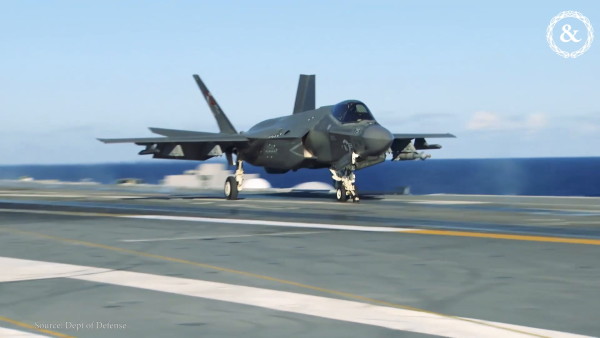

America’s most expensive weapon — Lockheed Martin’s F-35 Lightning II Joint Strike Fighter — is still struggling with a number of serious problems, such as destructive chain reactions triggered by a flat tire, a weird green glow on the helmet display that makes it difficult to land on aircraft carriers, and a loss of stealth at supersonic speeds.
Documents obtained by Defense News indicate that the U.S. military’s fifth-generation F-35 stealth fighters continue to suffer from more than a dozen issues that could potentially put pilots at risk or jeopardize a mission.
The F-35 program managed to cut the number of category 1 deficiencies down from 111 at the start of last year to 64 in May 2018 to just 13 as the aircraft headed into operational testing last fall. But some of the remaining issues are very problematic.
For instance, in cold weather conditions, the F-35 may falsely report that a battery has failed, a problem that has resulted in aborted missions.
When its hot out, older engines on the short takeoff/vertical landing variant sometimes have trouble producing the necessary thrust to keep the fighter in the air, leading to an unplanned a hard landing.
There have also been issues with unusual spikes in cabin pressure in the cockpit causing pain in the ears and sinuses, Defense News reports.

Two F-35C Lightning II aircraft.(U.S. Navy/Lt. Cmdr. Darin Russell)
One particular problem that really stood out to a retired fighter pilot was that in some cases, after completing certain maneuvers, F-35B and F-35C pilots have lost the ability to fully control the fighter’s pitch, roll, and yaw.
The F-35 program, by the U.S. military’s own admission, has been “troubled,” suffering from production problems, ballooning costs, delivery delays, and numerous technical challenges.
Acting Secretary of Defense Patrick Shanahan has colorfully described the F-35 program, the cost of which recently grew by tens of billions of dollars, as “f—ed up.”
News of the F-35s problems comes as the Pentagon and Lockheed discuss ramping up to full-rate production, increasing annual delivery from 91 to 160 jets within the next few years. The F-35 Joint Program Office told Defense News that not all of the problems will be addressed before the full-rate production decision.
While the problems reported by Defense News sound alarming, defense officials who spoke to the outlet downplayed their seriousness, with one explaining that the current category 1 deficiencies affecting the F-35 are ones “that have a mission impact with a current workaround that’s acceptable to the war fighter with the knowledge that we will be able to correct that deficiency at some future time.”
A naval aviator told the outlet that the current problems are “growing pains” that are to be expected.
Read more from Business Insider:
- Here’s what you need to know to understand the technical problems plaguing the F-35
- Watch the Air Force’s F-35 Demo Team commander break down each of his intense aerial acrobatics
- This Air Force C-17 crew broke diplomatic protocol to save a sailor’s life — and now they’re up for an award
- An ROTC cadet who was fond of Nazis and the KKK is getting the boot
- U.S. is planning to send another 1,000 troops and a squadron of drones to Poland to counter Russia